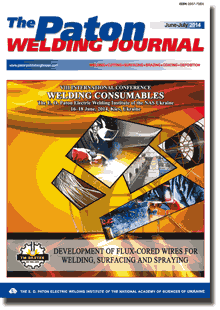| 2014 №06 (05) |
DOI of Article 10.15407/tpwj2014.06.06 |
2014 №06 (07) |

The Paton Welding Journal, 2014, #6-7, 31-34 pages
INTERACTION OF HYDROGEN WITH DEFORMED METAL
A.P. PALTSEVICH, V.S. SINYUK and A.V. IGNATENKO
E.O. Paton Electric Welding Institute, NASU. 11 Bozhenko Str., 03680, Kiev, Ukraine. E-mail: office@paton.kiev.ua
Abstract
This work investigates the peculiarities of formation of residual hydrogen as a result of plastic strain of metal, containing diffusible hydrogen. Characteristic of this process is increase of content of hydrogen trapped by dislocations, [H]def. It is testified by appearance of a peak in thermodesorption spectrum with maximum rate of removal at 150-170 °C as well as rise of [H]def at increase of plastic strain level. Also, it was experimentally showed that [H]def reduces after long period of storage of deformed specimens at room temperature. This confirms reversible nature of dislocations as hydrogen traps. A value of hydrogen diffusion coefficient in the plastically deformed weld metal is determined by interaction of hydrogen with dislocations and being 3 orders lower than for the undeformed metal. The experiments showed that rise of metal strength provides for reduction of value of plastic strain, at which fracture takes place, under effect of diffusible hydrogen. At that, content of [H]def in the moment of fracture also significantly decreases with increase of metal strength. 12 Ref., 3 Tables, 5 Figures.
Keywords: diffusible hydrogen, residual hydrogen, deformation-trapped hydrogen, plastic strain, hydrogen thermodesorption analysis
Received: 25.04.14
Published: 28.09.14
References
1. Geld, P.V., Ryabov, R.A. (1974) Hydrogen in metals and alloys. Moscow: Metallurgiya.
2. Geld, P.V., Ryabov, R.A., Kodes, E.S. (1979) Hydrogen and imperfections of metal structure. Moscow: Metallurgiya.
3. Novikov, I.I. (1975) Defects of crystalline structure of metals. Moscow: Metallurgiya.
4. Ivanova, V.S., Gorodienko, L.K., Geminov, V.N. et al. (1965) Role of dislocations in strengthening and fracture of metals. Ed. by V.S. Ivanova. Moscow: Nauka.
5. Gulyaev, A.P. (1978) Metals science. 5th ed. Moscow: Metallurgiya.
6. Kolachev, B.A. (1985) Hydrogen brittleness of metals. Moscow: Metallurgiya.
7. Maroeff, I., Olson, D.L., Eberhart, M. et al. (2002) Hydrogen trapping in ferritic steel weld metal. Int. Materials Rev., 47(4), 191-223. https://doi.org/10.1179/095066002225006548
8. Cotterill, P. (1963) Hydrogen embrittlement of metals. Successes of physics of metals. Vol. 9. Moscow: Metallurgizdat.
9. Pokhodnya, I.K., Yavdoshchin, I.R., Paltsevich, A.P. et al. (2004) Metallurgy of arc welding. Interaction of metals with gases. Kiev: Naukova Dumka.
10. Paltsevich, A.P. (1999) Chromatographic method for determination of hydrogen content in components of electrode coatings. Avtomatich. Svarka, 6, 45-48.
11. Choo, W.Y., Jai Yong Lee (1982) Thermal analysis of trapped hydrogen in pure iron. Metallurg. Transact. A, 13, 135-140. https://doi.org/10.1007/BF02642424
12. Moreton, G., Coe, F.R., Boniszewski, T. (1971) Hydrogen movement in weld metal. Pt 1. Metal Construction and British Welding J., 3(5), 185-187.
